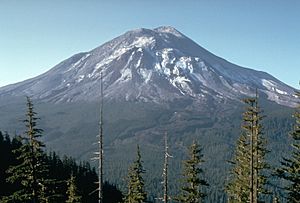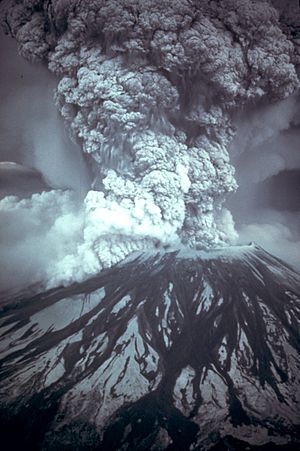Catastrophism facts for kids
Catastrophism is a scientific idea about how Earth has changed over time. It suggests that our planet has been shaped by sudden, powerful, and often worldwide events. These big events, like huge floods or asteroid impacts, happened quickly. They were followed by long periods where not much changed.
This idea was first named 'Catastrophism' in 1837. People who believed in it thought these sudden disasters were the main reason for the changes we see in Earth's rocks and fossils. The layers of rock seemed to show that Earth had faced huge, quick changes, even though it was mostly a quiet planet.
A famous scientist named Georges Cuvier supported this view. He was a top expert in studying animal bodies and ancient life (fossils) in the early 1800s. Cuvier showed that many species had completely disappeared, which is called extinction. He used catastrophism to explain why different types of animals and plants appeared in different rock layers. He didn't believe in evolution, but he also didn't use religious reasons for his ideas.
Contents
Different Ideas About Earth's Changes
Other scientists had a very different idea about how Earth changed.
Uniformitarianism: Slow and Steady Changes
Two important scientists, James Hutton and Charles Lyell, suggested a different view. Hutton's book, Theory of the Earth (1795), and Lyell's Principles of Geology (1830–33) described a different process.
This new idea was called uniformitarianism. It means that the same natural processes we see happening today (like erosion by water or wind, or volcanoes erupting slowly) have always been shaping Earth. These processes work very slowly over extremely long periods.
Lyell greatly expanded on Hutton's ideas. He showed many examples that could only be explained by slow, gradual changes. His books had a big impact on the young Charles Darwin. Darwin even took Lyell's first book with him on his famous voyage on the HMS Beagle.
How Old is Earth?
The age of Earth was also a big part of this discussion. In the 1800s, people thought Earth was maybe 100 million years old. But now, we know Earth is about 4.56 billion years old! This incredibly long time is definitely enough for slow, gradual processes to make huge changes.
Because of this, for a long time (from about 1840 to 1980), most geologists believed in uniformitarianism. Their main idea was: "the present is the key to the past." This meant that by studying what happens today, we can understand what happened long ago.
Both Ideas Are Right!
Eventually, scientists realized that both slow, gradual processes and sudden, rapid disasters have shaped Earth's history. It's not just one or the other.
A big reason for this change in thinking was the discovery that asteroid impacts and other quick events have played a huge role in Earth's past.
What Happened to the Dinosaurs?

In 1980, scientists Walter and Luis Alvarez suggested something amazing. They thought a huge asteroid, about 10 kilometers (6 miles) wide, hit Earth 65 million years ago. This happened at the end of the Cretaceous period.
This giant impact likely wiped out about 70% of all living species, including the dinosaurs. We call this the K/T extinction event. In 1990, scientists found a huge crater, about 180 kilometers (110 miles) wide, in Mexico. It's called the Chicxulub crater and is believed to be where the asteroid hit.
Today, scientists still discuss if the asteroid impact was the only cause of the dinosaur extinction. Some think massive volcanic eruptions from the Deccan Traps (which happened around the same time) also played a part. Both of these ideas involve huge, catastrophic events, even if the asteroid impact was much more sudden.
We even saw a catastrophic event happen in space! When Comet Shoemaker–Levy 9 crashed into Jupiter, it showed us that big, sudden collisions are natural events in our solar system.
How the Moon Was Made
Another example of a huge, sudden event is the idea of how our Moon formed. The giant impact hypothesis suggests that the Moon was created from the leftover pieces of a massive collision. This happened when a young Earth was hit by a protoplanet about the size of Mars. This is the most accepted scientific idea for how the Moon came to be.
See also
 In Spanish: Catastrofismo para niños
In Spanish: Catastrofismo para niños


